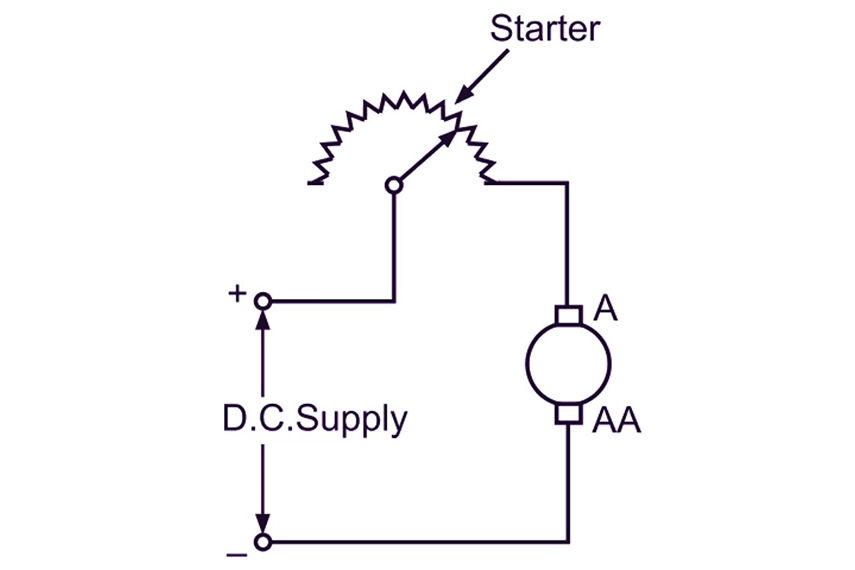DC Motor Starting Methods
2024-08-20 17:07:34
DC motors are widely used in various applications due to their excellent speed control and torque characteristics. However, starting a DC motor can pose significant challenges, primarily due to the high inrush current and initial torque. Understanding and implementing effective starting methods is crucial to ensure the longevity and efficiency of DC motors. This article delves into the various DC motor starting methods, their principles, and their applications.

Introduction to DC Motor Starting Challenges
When a DC motor is started, it initially draws a very high current from the power supply. This high inrush current is due to the low initial resistance of the motor's armature winding and the absence of back EMF (Electromotive Force). If not controlled, this surge in current can cause significant damage to the motor windings, the power supply, and associated equipment. Additionally, the high starting torque can lead to mechanical stress and wear. Therefore, employing appropriate starting methods is essential to mitigate these risks.
Key DC Motor Starting Methods
-
Direct-On-Line (DOL) Starting
Principle
In the Direct-On-Line (DOL) starting method, the DC motor is connected directly to the power supply. This method is the simplest and involves the use of a switch or contactor to connect the motor terminals to the power source.
Advantages
- Simplicity: The DOL method is straightforward and does not require complex circuitry.
- Cost-Effective: Minimal components are needed, making it a cost-effective option.
Disadvantages
- High Inrush Current: The motor draws a very high starting current, which can be several times the full-load current.
- Mechanical Stress: The high starting torque can lead to mechanical wear and tear.
Applications
- Small Motors: Suitable for small motors where the high starting current and torque are manageable.
- Low-Inertia Loads: Used in applications with low-inertia loads where mechanical stress is less of a concern.
-
Starter Resistor Method
Principle
The starter resistor method involves inserting resistors in series with the motor armature during startup. These resistors limit the initial current. As the motor speeds up and the back EMF increases, the resistors are gradually removed from the circuit.
Advantages
- Reduced Starting Current: Limits the initial surge of current, protecting the motor and power supply.
- Controlled Acceleration: Provides smoother acceleration, reducing mechanical stress.
Disadvantages
- Heat Dissipation: The resistors need to dissipate heat, requiring adequate cooling mechanisms.
- Efficiency Loss: Some energy is wasted in the resistors, reducing overall efficiency.
Applications
- Medium-Sized Motors: Used in medium-sized motors where controlling the starting current is crucial.
- Applications Requiring Smooth Starts: Ideal for applications where gradual acceleration is necessary.
-
Armature Resistance Starting
Principle
In the armature resistance starting method, resistors are placed in series with the motor armature winding. As the motor accelerates and builds up back EMF, the resistors are gradually bypassed or short-circuited.
Advantages
- Effective Current Limitation: Provides an effective way to limit starting current.
- Smooth Transition: Allows for a smooth transition from starting to running conditions.
Disadvantages
- Energy Loss: Similar to the starter resistor method, energy is lost in the resistors.
- Space Requirement: The resistors occupy space and require proper mounting.
Applications
- Variable Torque Loads: Suitable for motors driving variable torque loads.
- Applications Requiring Controlled Starts: Used where controlled and smooth starts are necessary.
-
Series-Parallel Starting
Principle
Series-parallel starting involves connecting the motor windings in series during startup and then switching them to a parallel configuration once the motor reaches a certain speed. This method is commonly used in motors with multiple windings.
Advantages
- Reduced Starting Current: The series connection during startup reduces the current.
- Enhanced Control: Provides better control over starting conditions.
Disadvantages
- Complexity: The switching mechanism adds complexity to the system.
- Maintenance: Requires regular maintenance to ensure reliable operation.
Applications
- Large Motors: Suitable for large motors where controlling the starting current is essential.
- High-Inertia Loads: Used in applications with high-inertia loads requiring controlled acceleration.
-
Soft Starters
Principle
Soft starters use solid-state devices like thyristors to gradually increase the voltage supplied to the motor. This method allows for smooth acceleration and limits the inrush current.
Advantages
- Smooth Acceleration: Provides very smooth acceleration, reducing mechanical stress.
- Adjustable Parameters: Allows for adjustment of starting parameters to suit specific applications.
Disadvantages
- Cost: More expensive compared to traditional methods.
- Complexity: Requires more sophisticated control systems.
Applications
- Sensitive Equipment: Ideal for applications involving sensitive equipment that cannot tolerate high starting currents.
- Industrial Applications: Widely used in industrial applications where smooth starts are critical.
-
DC Electronic Controller
Principle
DC drive systems control the motor's starting by regulating the voltage and current supplied to the motor using electronic controllers. These systems provide precise control over the motor's performance during startup.
Advantages
- Precise Control: Offers very precise control over starting current and torque.
- Versatility: Can be programmed to suit a wide range of applications.
Disadvantages
- High Initial Cost: DC drive systems are relatively expensive.
- Complexity: Requires sophisticated electronics and control algorithms.
Applications
- High-Performance Applications: Used in applications requiring high performance and precise control.
- Automated Systems: Ideal for automated systems where control over motor operation is essential.
Conclusion
Selecting the appropriate starting method for a DC motor is crucial to ensure efficient and reliable operation. Each method has its advantages and disadvantages, making it suitable for specific applications. Understanding the principles and applications of each starting method allows you to make informed decisions, ensuring the longevity and performance of DC motors in various industrial and commercial applications.
See What Lunyee Can Do For You
Contact Us
- 8619149417743
- +86-0371-5562 0274
- [email protected]
- Zhengzhou, Henan Province, China
- Mon-Fri: 9:00 - 18:00




